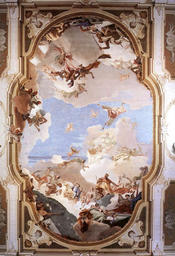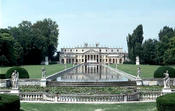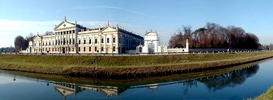

|
The ample hall decorated with frescos has the walls painted with
pillars, producing a perfectly working plastic effect and outlining
dummy architectural elements that surround the central work depicting
the "Glory of the Pisani family". The latter represents
the members of the family surrounded by allegorical personifications
of the Arts, the Sciences and the Geniuses of Peace, before Power
and beneath the Virgin observing with benevolence Fame explaining
the glory and the power of the Pisani family to the world represented
by the continents. This fresco was painted by Gianbattista Tiepolo
between 1760 and 1762 before he left for Spain. The banquet hall
presents with remarkable monochromatic decorations on the gallery
painted by Gian Domenico Tiepolo and with the brass gates at the
doors which have been attributed to Giuseppe Casa. In the approximately
10 hectares of the park of the villa Pisani there are the main buildings
of the park. First of all the stables, an imposing perspective backdrop
and a theatric scene, with its curved wings that improve sonority,
essential to characterize the equestrienne inspiration of the park
à la Vitruvio. Another symbolic element that must have been
one of the first realizations is the labyrinth, originally planned
as circular and inspired, with its turret served by a double helix
that leads to the statue of Minerva, to a ritual conquer of wisdom.
The character of a game is reflected by the presence of a hiding
place, by the possibility of meeting the others again while walking
through the labyrinth in illusory frames that recall paintings and
sculptures and by the peculiar hexagonal exedra with curved sides,
where a winding staircase leads to a belvedere with a round window
that allows those who are downstairs to see, like in a painting
of Mantegna or Coreggio, who is upstairs. The exedra is also the
center from where many of the perspective axis start, that have
on the other end the citrus orchard, the sculpture groups of Bonazza
and the fencing portals, among which the most interesting one is
the one called "of the Belvedere", characterized by a
double slope, around gigantic columns, that leads to the suspended
crowning path. Also those realizations that are more tied to a practical
use, like the houses of the gardeners beside the exedra and the
tea time lodge with the ice-house underneath, participate to the
theatricality of the complex, that is strong enough to transform
the former in a light green backdrop and the latter in a artificial
hill surmounted by a little palace. Only the greenhouses completed
in the first half of the 19th century, present, with their technological
refinement, an austerely utilitarian character. With the collapse
of the Serenissima the villa was sold to Napoleon who donated it
to the Viceroy of Italy Eugenio Beauharnais. In 1814 the villa fell
into the hands of the Emperor of Austria and in 1866 in those of
the Savoy family and was finally ceded to the public domain in 1882.
|




